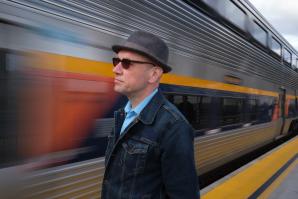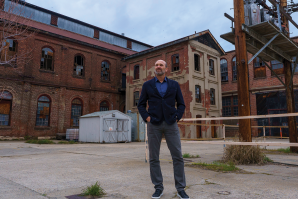The saga of California high-speed rail, a twisting tale two decades in the making, seemed to be coming to an abrupt end this summer. In July, the Trump administration announced it would pull back $4 billion in funding destined for the first leg of the route, which would eventually connect the Central Valley cities of Bakersfield and Merced. Writing on his own social media website, Truth Social, President Trump said, “The Railroad we were promised still does not exist, and never will. This project was Severely Overpriced, Overregulated, and NEVER DELIVERED.”
In August, California reached an agreement with the Federal Railroad Administration that would protect this $4 billion in a legal trust while a lawsuit plays out over the funding, CapRadio reports. Meanwhile, the state’s high-speed rail authority has continued to plug away at the Central Valley stretch of the project, even as the Trump administration canceled another $175 million in funding. Though no track has been laid on a route that was initially planned to connect San Francisco to Los Angeles by 2020, workers are nearing completion on the Hanford Viaduct, an elevated structure south of Fresno. Bridges and other structures are also slowly taking shape across the Central Valley.
As Comstock’s previously revealed in our award-winning coverage of Valley Rail — a long-stalled extension of the existing Altamont Commuter Express planned to eventually connect Sacramento and other Central Valley towns with the high-speed rail line — California regulations are not the only factors slowing down rail development in the state. Projects can also run aground due to interference from the patchwork of private and public interests involved in large-scale development. We looked into the recent history of California’s high-speed rail to understand some of the obstacles preventing it from staying on track.
This rendering shows what high-speed trains may look like as they
race across the Central Valley. (By California High-Speed Rail
Authority, public domain via Wikimedia Commons)

Warning signs
The potential withdrawal of funding was signaled earlier this summer, when the Federal Railroad Administration completed a review of the California High-Speed Rail Authority’s project in June. The report claimed missed deadlines, budget shortfalls and inflated ridership claims but gave the CHSRA a chance to respond. The FRA felt the response sent did not address its concerns and terminated the $4 billion in federal grants.
The FRA claims its review was initiated by a February report completed by the office of the inspector general at CHSR. That review concluded the Authority was “unlikely” to complete the Merced to Bakersfield high-speed rail project within the 2030-33 “schedule envelope” it had previously envisioned. However, the OIG has called this claim a mischaracterization of its report and went so far as to issue a public letter on the matter because “the FRA did not provide our office an opportunity to review and correct these mischaracterizations prior to publishing its compliance review report.”
The CHSRA issued a forthright response to the termination at the time it was first proposed, with CEO Ian Choudri calling it “unwarranted and unjustified.” Choudri also claimed that the FRA report was “based on an inaccurate, often outright-misleading, presentation of the evidence.” Many of the FRA’s objections related to what it characterized as a failure to plan for a projected $7 billion funding gap.
The Cedar Viaduct was completed in May 2023 and is intended to
carry high-speed trains over State Route 99 south of Fresno. (By
California High-Speed Rail Authority, public domain via Wikimedia
Commons)

However, the CHSRA says a combination of public-private initiatives and use of Cap-and-Invest funds would address this, claiming that they would be guaranteed at least $1 billion per year from the carbon credit program which has been extended until 2045. Central Valley residents might be fearing the worst with the withdrawal of federal funds, but CHSRA believes it has both a legal right to the funds and a backup plan should they not succeed in court.
The CHSRA also noted that an FRA report in October 2024 found no significant compliance issues. Indeed “the Authority has met every obligation, as confirmed by repeated federal reviews, as recently as February 2025,” according to Choudri. The CSHRA CEO also highlighted the significant progress that has been made, especially when compared to other states which remain in the conceptual stage of their own high-speed rail plans.
“America’s only high-speed rail project underway is fast approaching the track-laying phase, with 171 miles under active construction and design, 15,500 jobs created, and more than 50 major structures completed. This is no time for Washington to walk away on America’s transportation future,” Choudri said.
The grants in question were part of the FRA’s High-Speed Intercity Passenger Rail Program, and the Federal-State Partnership. The initial funding was awarded to the CHSRA in fiscal year 2010 following the state’s voters approving a bond for the project in a 2008 ballot initiative, and additional FSP funds were awarded as recently as December of 2023. The initial plan for the high-speed rail project proposed to have trains running by this decade, but the timeline has been pushed back further as costs have grown.
Construction continues on the California High Speed Rail project
in Corcoran, June 2025. (Shutterstock photo)

Despite this, it remains years ahead of states like Texas, which was in the planning phase of its own high-speed rail project when funding was cut by the Trump administration in April of this year. Funding for other rail initiatives, including the Northeast Corridor high-speed rail program, has also been cut in the 2025 budget bill.
Sinking issues
This is not the first time the federal funding for California’s high-speed rail has been called into question. In 2019, the first Trump administration terminated a $929 million federal grant. This was challenged in court by the state, and in 2021 a settlement with the Biden administration restored the full amount.
This time a court case would likely be more challenging, as the state will face the Trump administration. Despite this, the CHSRA has already filed a lawsuit against the Trump administration. In a statement, Gov. Gavin Newsom said, “Trump’s termination of federal grants for California high-speed rail reeks of politics. It’s yet another political stunt to punish California.”
This USGS archival photo from 1977 demonstrates how much
subsidence had taken place due to groundwater pumping between
that date and 1925. (Public domain via Wikimedia Commons)

Subsidence has already slowed down construction. In 2023 and 2017, wet winters resulted in flooding, and it poses a risk to the operability of the lines once they are completed. It will also likely make the construction of track even more expensive, as tracks will need to be elevated above the surrounding terrain to reduce flood risk.
Other sources of federal funding, such as the federal Rail Crossing Elimination program which provides grants to make both road and pedestrian rail crossings safer, are not impacted by the FRA’s announcement. CHSRA spokesperson Kyle Simerly told Comstock’s that there would not be an immediate impact on construction.
“The project has primarily been funded by state sources. A supplemental report later this summer will update funding requirements, schedules, ridership and cost estimates.” Most importantly, Simerly said in an emailed response to questions from Comstock’s, “There will be no immediate impact on construction.”
–
Subscribe to the Comstock’s newsletter today.
Recommended For You

What’s Holding Up Valley Rail?
The need and the plan are there, but bureaucracy once again slows progress
The project has been caught in spiraling delays, and launch dates have been pushed back to 2030. The San Jose Regional Rail Commission broke ground on just one of the half dozen proposed new stations as of late summer 2024.

Valley Rail on Track
A new commuter rail service is coming to the Capital Region
In the notoriously car dependent Central Valley, a new public transit option could have significant impacts on mobility and quality of life, as well as economic development. But delays to the Valley Rail project are reflective of the challenges involved in building intercity passenger rail anywhere in the United States.

Transcontinental Railroad Turns 150
The construction of the First Transcontinental Railroad was one of the greatest engineering feats in American history, one whose ramifications are felt to this day. The six-year project involved two competing railroad companies laying nearly 1,800 miles of track across the continent, linking west with east.

Rail Warriors
As more workers commute by train, Amtrak has plans to get them there quicker
It’s safe to say Jeffrey Callison never gives a thought to the Transcontinental Railroad when his alarm wakes him at 5:25 a.m., even though May 10 marks the TCRR’s 150th anniversary.

Resurrecting the Railyards
After a major environmental cleanup, ground is expected to be broken this year on a new hospital, stadium and entertainment center
The Railyards, an urban infill project, promises to transform downtown Sacramento, nearly doubling its existing size. The property consists of 240 acres north of the Amtrak station on H Street and east of Interstate 5.



